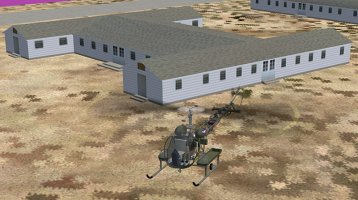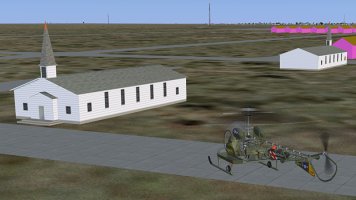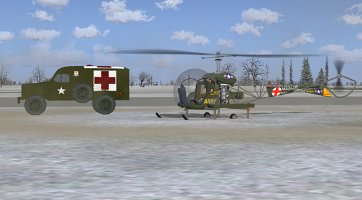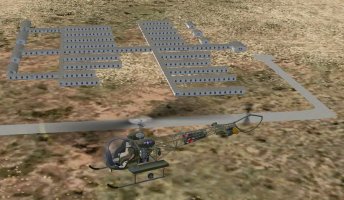So, you want to be a Rotorhead...
Step 1 - Selecting your first helicopter.
Some thoughts when selecting a helicopter to focus on basic helicopter skills (ground maneuvers).
The biggest drawback to any PC based sim helicopter, compared to an actual helicopter, has nothing to do with the programing of flight dynamics, or the number or sophistication of gauges or autopilot/FMS, it is simply the lack of visual cues when looking outside the cockpit.
The helicopter pilot uses so many subtle visual cues for aircraft movement. When in the hover, while hover taxiing, when transitioning from the hover to forward flight, and when transitioning from forward flight to the landing, peripheral vision plays a predominant role in acquiring those movement cues.
With the sim, peripheral cues are all but non-existent. The best we can do is pan back while using the virtual cockpit (VC), accepting a loss of panel detail to gain more outside visual width.
So, starting with the premise of "the more outside view the better" let's take a look at a wide selection of available helicopters and discuss their plusses and minuses for outside visual primarily while in ground effect (IGE). When out of ground effect (OGE) or while in forward flight, just as in a fixed wing aircraft, ground visual references play less of a role and aircraft position in reference to the horizon takes the lead. The following pictures are to give you an idea of the broad differences that exist in cockpit visibility with several helicopters.
Let's first look at helicopters that are often used for primary flight training. These being the Bell 47, Hughes/Schweizer 300, and Robinson R-22.
One can clearly see that the B-47, H/S-300, and R-22 offer exceptional visibility due to their large amount of unobstructed plexiglass surrounding the pilot.



When we consider helicopters that are often used for intermediate/advanced flight training we look to the Bell 206 JetRanger and the Aérospatiale Alouette III.
Both these aircraft offer good visibility in addition to good VFR/IFR instrument panels.


The remainder of the examples are corporate, utility, or military helicopters with much less visibility, but with other strengths such as maneuverability, payload capacity, IFR and/or icing certification, or similar capabilities. Some have strong IFR panels with FMS and/or autopilot.
In sim flying these aircraft allow for flying various real-world scenarios (EMS, Combat, Firefighting) an flying to destination using the IFR route structure.
Agusta Westland EC135, Agusta Westland EH101, Bell H-1 Huey, Bell AH-1S Cobra, Bell 412, Eurocopter AS332, Eurocopter EC135, Hughes OH-6, and Silorsky S-55.









My recommendation is to initially fly smaller, less "capable" helicopters that favor good outside visibility. The less systems the better. And if it is perceived as a hard aircraft to hover, stick with it. If you can master ground reference maneuvers in this, anything else becomes easy. And don't worry about reciprocating vs turbine because, with very few exceptions, these will fly the same utilizing a governor to maintain rotor RPM with increase of power.
Stay tuned, as we get your selected helicopter into the air.
Step 1 - Selecting your first helicopter.
Some thoughts when selecting a helicopter to focus on basic helicopter skills (ground maneuvers).
The biggest drawback to any PC based sim helicopter, compared to an actual helicopter, has nothing to do with the programing of flight dynamics, or the number or sophistication of gauges or autopilot/FMS, it is simply the lack of visual cues when looking outside the cockpit.
The helicopter pilot uses so many subtle visual cues for aircraft movement. When in the hover, while hover taxiing, when transitioning from the hover to forward flight, and when transitioning from forward flight to the landing, peripheral vision plays a predominant role in acquiring those movement cues.
With the sim, peripheral cues are all but non-existent. The best we can do is pan back while using the virtual cockpit (VC), accepting a loss of panel detail to gain more outside visual width.
So, starting with the premise of "the more outside view the better" let's take a look at a wide selection of available helicopters and discuss their plusses and minuses for outside visual primarily while in ground effect (IGE). When out of ground effect (OGE) or while in forward flight, just as in a fixed wing aircraft, ground visual references play less of a role and aircraft position in reference to the horizon takes the lead. The following pictures are to give you an idea of the broad differences that exist in cockpit visibility with several helicopters.
Let's first look at helicopters that are often used for primary flight training. These being the Bell 47, Hughes/Schweizer 300, and Robinson R-22.
One can clearly see that the B-47, H/S-300, and R-22 offer exceptional visibility due to their large amount of unobstructed plexiglass surrounding the pilot.



When we consider helicopters that are often used for intermediate/advanced flight training we look to the Bell 206 JetRanger and the Aérospatiale Alouette III.
Both these aircraft offer good visibility in addition to good VFR/IFR instrument panels.


The remainder of the examples are corporate, utility, or military helicopters with much less visibility, but with other strengths such as maneuverability, payload capacity, IFR and/or icing certification, or similar capabilities. Some have strong IFR panels with FMS and/or autopilot.
In sim flying these aircraft allow for flying various real-world scenarios (EMS, Combat, Firefighting) an flying to destination using the IFR route structure.
Agusta Westland EC135, Agusta Westland EH101, Bell H-1 Huey, Bell AH-1S Cobra, Bell 412, Eurocopter AS332, Eurocopter EC135, Hughes OH-6, and Silorsky S-55.









My recommendation is to initially fly smaller, less "capable" helicopters that favor good outside visibility. The less systems the better. And if it is perceived as a hard aircraft to hover, stick with it. If you can master ground reference maneuvers in this, anything else becomes easy. And don't worry about reciprocating vs turbine because, with very few exceptions, these will fly the same utilizing a governor to maintain rotor RPM with increase of power.
Stay tuned, as we get your selected helicopter into the air.




